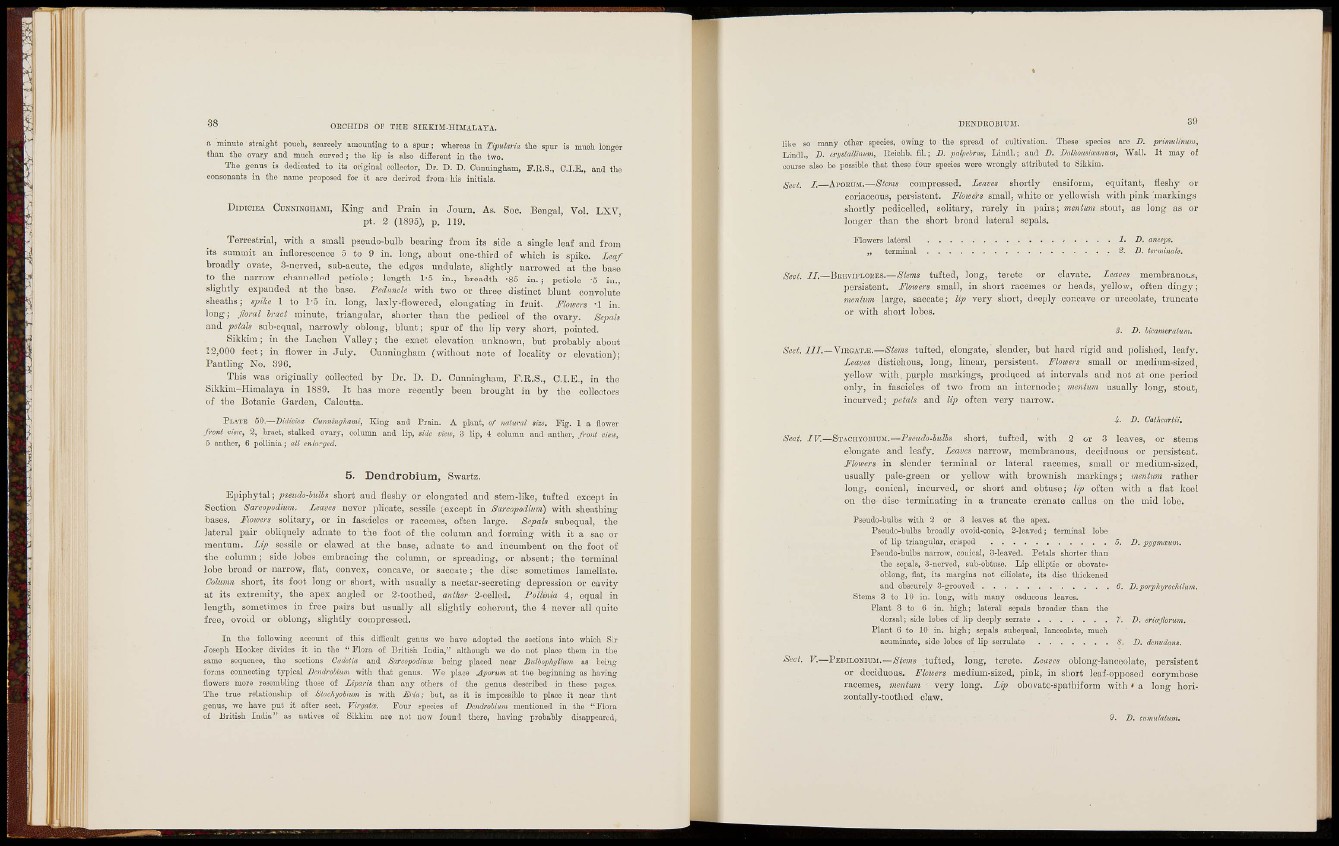
OECniDS OF THE SIRKILIJ-IIMALArA.
a mirnito straight pouch, scarcely amounting to a spur; whereas in Tipulam tlie spur is muoh longer
than the ovary and much ciu-ved j the lip is also different in the two.
The gonus is dedicated to its original coUootor, Dr. D. D. Cuntungham, F.R.S., C.I.R, and the
consonants in the name proposed for it are derived from his initials.
DIDICIEA CUNNINGHAMI, King and Praia in Journ. As. Soc. Bengal, Vol. LXV,
pt. 2 (1895), p. 119.
Terrestrial, with a small pseudo-bulb bearing from its side a single leaf and from
its summit an inflorescence 5 to 9 in. long, about one-third of which is spike. Leaf
broadly ovate, S-uerrcd, sub-acute, the edges umlulate, slightly narrowed at the base
to the narrow channelled petiole; length 1-5 iu., breadth -So in.; petiole -5 in.,
slightly expanded at the base. Pechmcls with two oi' three distinct blunt convolute
s h e a t h s ; spike I to I'o in. long, laxly-flowered, elongating iu fruit. Flowers -1 in.
l o n g ; floral Iraci minute, triangular, shorter than the pedicel of the ovary. Sepah
and pstah sub-equal, narrowly oblong, blunt; spur of the lip very short, pointed.
Sikkiiu; in the Lachen Valley; the exact elevation unknown, but probably about
12,000 feet; in flower in July. Cunningham (without note of locality or elevation);
P a n t l i n g No. 396.
This was originally collected by Dr. D. D. Cunningham, F.R.S., C.I.E,, in the
Silikim-Himalaya in 1889. It has more recently been brought in by the collectors
of the Botanic Garden, Calcutta.
PLATE Z^.—Lidima Cunningkami, King and Prain. A plant, of natural siso. Pig. 1 a flower
front mow, 2, bract, stalked ovary, column and lip, side vieiv, 3 lip, 4 column and anther, front view,
5 anther, 6 pollinia; ail enlwged.
5. Dendrobium, Swartz.
E p i p h y t a l ; pseudo-hulha short and fleshy or elongated and stem-like, tufted except in
Section Sarcopodium. Leaves never plicate, sessile (,escopt iu Sarcopoditm) with sheathing
bases. Fiowers solitary, or in fascicles or racemcs, often large. Sepals subequal, the
lateral pair obliquely adnato to the foot of the column and forming with it a sac or
mentum. Lip sessile or clawed at the base, adnate to and incumbent on the foot of
t h e column; side lobes embracing the column, or spreading, or absent; the terminal
lobe broad or narrow, flat, convex, concavc, or saccate; the disc sometimes lamellate.
Column short, its foot long or short, with usually a nectar-secreting depression or cavity
a t its extremity, the apes angled or 2-toothed, anther 2-cellcd. Poliinia 4, equal in
length, sometimes in free pairs but usually all slightly coherent, the 4 never all quite
free, ovoid or oblong, slightly compressed.
In the following account of this difficult geuus we have adopted the sections into which Sir
Joseph Hooker divides it in the " Flora of British India," althuugh we do not place them iu the
same sequence, the sections Cadetia and Sarcopodium being placed near Balbophyilwii as being
forms connecting typical Dendrobium with that genus. We place Ajmrni at the beginning as having
fiowers more resembling those of Lipavis than any others of the genus described in those pagts.
The true relationship of Stachyobium is with Eria; but, as it is impossible to place it near that
genus, we have put it after sect. Virrjatm. Four species of Dendrobium mentioned in the "Flora
of iiiitish India" as natives of Sikkim are not now found there, having probably disappeared,
DENDEOBIUM. 30
like so many other species, owing to the spread of cultivation. These species are D. primulimim,
Liudl., D. crystalUnum, Ileichb. fil.; D. palpebrao, Lindl.; and D. Dalhomioeauum, Wall. It may of
coiuae also be possible that these fom- species were wrongly attributed to Sikkim.
^cct. I. APOEUAI.—Stems compressed. Leaves shortly ensiform, equitant, fleshy or
coriaceous, persistent. Floioers small, white or yellowish with pink 'markings
shortly pedicelled, solitary, rarely in pairs; mentum stout, as long as or
longer than the short broad lateral sepals.
Flowers lateral .. . . 1. D. anceps.
„ terminal S. D. torminale.
Sect. J/.—BREYIFLOHES.—^FEMIS tufted, long, terute or clavato. Leaves membranous,
persistent. Flowers small, in short racemes or heads, yellow, often dingy;
mentum large, saccate; lip very short, deeply concave or urceolatc, truncate
or with short lobes.
3. D. bieameratum.
Scot. 77/.—ViRGATiE.—Stems tufted, elongate, slender, but hard rigid and polished, leafy.
Leaves distichous, long, linear, persistent. Flowers small or medinm-sizedj
yellow with,pur23lo markings, produced at intervals and not at one period
only, in fascicles of two from an intcrnode; mentum usually long, stout,
incurved; petals and lip often very narrow.
h. D. Catlicarliu
Seci. IV.—ST^iCeYOBiiTM.—Pseudo-bulbs short, tufted, with 2 or 3 leaves, or stems
elongate and leafy. Leaves narrow, membranous, deciduous or persistent.
Flowers in slender terminal or lateral racemes, small or medium-sized,
usually pale-green or yellow with brownish markings ; mentum rather
long, conical, incurved, or short and obtuse; hp often with a flat keel
on the disc terminating in a truncate crenate callus on the mid lobe.
Pseudo-bulbs with 2 or 3 leaves at the apes.
Pseudo-bulbs broadly ovoid-conic, 2-leaved; terminal lobe
of lip triangular, crisped 5. D. pijgmoeum.
Pseudo-bulbs naiTOW, couica!, 3-leaved. Petals shorter than
the sepals, 3-nerved, sub-obtuse. Lip elliptic or obovateoblong,
flat, its margins not ciHolate, its disc thickened
and obscurely 3-grooved 6. D. porphyrochihim.
Stems 3 to 10 in. long, with many caducous leaves.
Plant 3 to 6 in. high; lateral sepals broader than the
dorsal; side lobes of lip deeply serrate 7. D. eria>Jlortim.
Plant 6 to 10 in. high; sepals subequal, lanceolate, much
acuminate, side lobes of lip serrulate 8. D. demtdans.
Sect. V.—PEDILONIUSI.—Stems tufted, long, terete. Leaves obloug-lanceolate, persistent
or deciduous. Flowers medium-sized, pink, in short leaf-opposed corymbose
racemes, mentum very long. Lip obovatc-spathiform with » a long horizontally
toothod claw.
9. B. cimidatum.